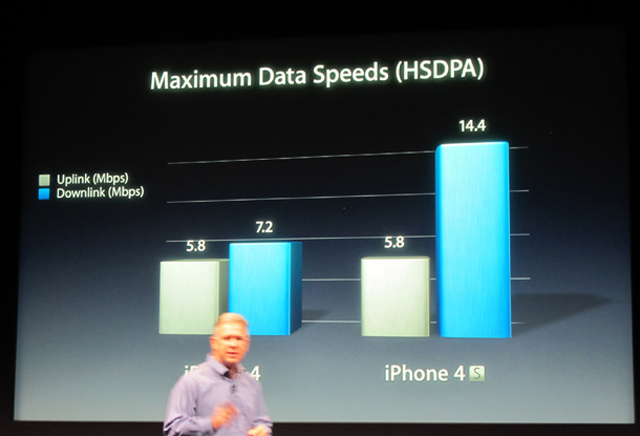AT&T has been maligned for years because of the poor quality and reliability of its network, but the wireless carrier was thrown a major bone by Apple on Monday with its new iPhone 4S. The iPhone 4S chipset supports the fastest 4G-like data speeds on AT&T, but only works on slower 3G networks on Verizon and Sprint.
[aditude-amp id="flyingcarpet" targeting='{"env":"staging","page_type":"article","post_id":338733,"post_type":"story","post_chan":"none","tags":null,"ai":false,"category":"none","all_categories":"mobile,","session":"B"}']The exact same iPhone 4S models will be sold on AT&T, Verizon and Sprint starting on Oct. 14. Each of those carriers will use marketing to help differentiate why a customer should pick their network. While each of the three networks has good points, AT&T might have the most convincing argument for technology enthusiasts: pure speed.
Since the iPhone 4S does not offer true 4G like LTE or WiMAX, it was thought by many to be underwhelming. Apple likely didn’t include LTE or WiMAX because they are major battery killers, but the company did increase data speeds to match other HSPDA AT&T phones such as the HTC Inspire 4G and LG Thrill 4G.
AI Weekly
The must-read newsletter for AI and Big Data industry written by Khari Johnson, Kyle Wiggers, and Seth Colaner.
Included with VentureBeat Insider and VentureBeat VIP memberships.
The new iPhone 4S supports what is called 14.4 HSDPA data. This means the phone can have download speeds up to 14.4 Mbps and upload speeds up to 5.8 Mbps on supported networks. AT&T offers 14.4 HSDPA in many of its markets already, and a spokesperson told me the company “expects” two-thirds of the company’s 3G network to offer 14.4 or greater HSDPA peak speeds by the end of the year. If you want to watch streaming movies, listen to streaming music or download large apps, AT&T will unquestionably be the fastest network.
Verizon and Sprint are another story. The 3G speeds on both networks typically fluctuate between 600 kbps and 1.4 Mbps for downloads, and between 500 and 800 kbps for uploads. Customers will likely see peaks speeds up to 2.5 Mbps (I’ve seen this speed on both networks), but it is not consistent. Watching Netflix movies or streaming songs from Rdio will be a lot less enjoyable using Verizon and Sprint’s 3G data networks.
When it comes to finding ways to compensate for slower data speeds, Verizon and Sprint do have some big advantages. First, Verizon has the strongest and most reliable voice network, so if you call people all the time, Verizon might be a more suitable choice. Second, Sprint is the only carrier of the three to offer an unlimited data package, and it has as well as the least expensive monthly pricing.
AT&T is typically the least reliable of the three above networks at establishing voice and data connections. But the network has gotten better over the years, as it has added enhanced backhaul for faster speeds and added more coverage to better compete with Verizon’s expansive 3G network.
As someone who will likely purchase an iPhone 4S, I’ve had to take all of these factors into consideration. As a denizen of New York City, all three networks have done their best at providing high-quality 3G coverage. In real testing, Verizon’s voice network is the best while AT&T provides the fastest data speeds. Sprint has been reliable in voice and data, but it hasn’t dramatically stood out. I’ll have to continue weighing all the pros and cons, but if I’m being honest, speed matters most and AT&T will be the best choice for that.
VentureBeat's mission is to be a digital town square for technical decision-makers to gain knowledge about transformative enterprise technology and transact. Learn More
